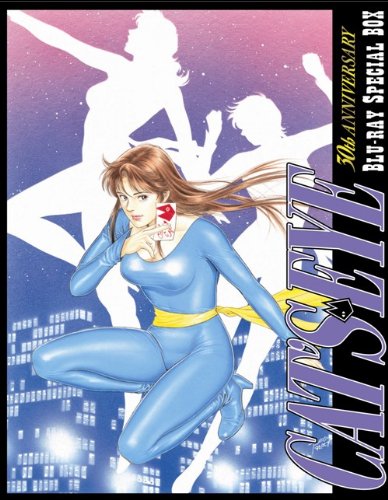
In this entry for Best Recommendations for Top Manga, we are going to cover Tsukasa Hojo. Born in Kitakyushu in Fukuoka prefecture on March 5, 1959, as the second son of an architect and a housewife, ever since he could remember, Hojo-sensei loved drawing pictures. During his boyhood, he enjoyed manga, anime, and tokusatsu and had the occasional dream of becoming a manga artist. Following in his father’s footsteps, he studied architecture in high school and university. However, as we can all see, he decided to use his talents to become a hit manga artist, but like all stories to success, the road wasn’t easy. Upon starting out in his hometown in Fukuoka with no money, he decided to enter manga contests to get noticed and get the grand 1,000,000 yen prize money. His submission was Space Angel, which got him second place and with a cash prize of 200,000 yen.
After that, he moved to Tokyo and the rest is history. Last, what makes him very distinct (and probably due to his educational background) compared to a good majority of other artists is that he tends to draw in a more realistic sense as opposed to the standard big eyes that anime and manga are known for. His art book commemorating his 30 years as a manga artist shows his evolution and how distinct he is from his peer group. So if you want to read manga that is more anatomically accurate, his manga may be what you’re looking for. So what are the manga titles that made him? Read these recommendations to find out!
5. Angel Heart

- Genre: Action, Drama, Mystery, Romance, Comedy
- Volumes: 33
- Published: May 2001 – August 2010
Kicking off our list is Angel Heart, what Hojo-sensei calls an alternate universe sequel to City Hunter, his big hit from the 1980s. While City Hunter is more comedy driven, Angel Heart has a much darker story. A few years after the events of City Hunter, Ryo and Kaori are finally about to tie the knot. But Kaori sees a girl about to get run over by a car and she sacrifices herself to save the girl. Wanting to live on and in hopes of finding Ryo again, she decides to donate her heart. Her heart is stolen, sold on the black market, and given to a Taiwanese teenage female assassin with the codename, Glass Heart, after falling into a coma from a mission. After receiving Kaori’s heart, Glass Heart has visions of Kaori’s life and of Ryo. After waking up from her coma, Glass Heart goes to Shinjuku to meet Ryo, who takes her in as his foster daughter and they go solve mysteries.
The series appropriately takes place in the same gap when City Hunter ended in the early-1990s and when the series starts in the early-2000s. It addresses the changes that have happened domestic and abroad between now and then. In the old City Hunter series, if you wanted to hire him, you go to a bulletin board at Shinjuku station and write down XYZ. With cell phones progressively being used by everyday citizens, this means of contact has become obsolete. It is ultimately a story about redemption for Glass Heart, who has been used to kill and for Ryo to overcome the loss of Kaori. Considering this is one of Hojo-sensei’s most recent works, his art style at this point has beautifully evolved to a more realistic tone as described in the introduction. This is very prominent with his male characters, but his female characters are a mix of the realistic tone along with the generic designs.
4. Ore wa Otoko Da!
- Genre: Action, Delinquent, Comedy, School
- Volumes: 1 (Part of a short story collection tokuban called Tenshi no Okurimono)
- Published: July 1980
Ore wa Otoko Da is Hojo-sensei’s debut into Shounen Jump. It is about a rivalry between Otokodate Boy’s High School and the Saint Carolina’s Academy for girls. The leader of the boys is Sho Yamato, who doesn't trust girls due to childhood trauma. The leader of the girls is Yuko Iwasaki. In due time, their schools are about to combine and worlds are about to collide!
This manga is Hojo-sensei’s of exploring how Japan was changing during this time period. Japan between the 70s and 80s was progressively becoming an economic powerhouse and their society was going through rapid changes, and yet there were some aspects stuck in the old ways. In addition, the Western influence was entering Japan and into the youth and Hojo-sensei also wanted to express that. In the end, the manga teaches its readers to put aside their differences and accept each other for who they are and also accept the inevitabilities of changes. Due to how early in his career the series was published, the art is rather generic but heavy on the ink. The fashion and hairstyles are very reflective of the times with men starting to have long hair. But in terms of women, they are sexy and yet commanding, which would be a trait that would stay throughout Hojo-sensei’s career.
3. Tenshi no Okurimono
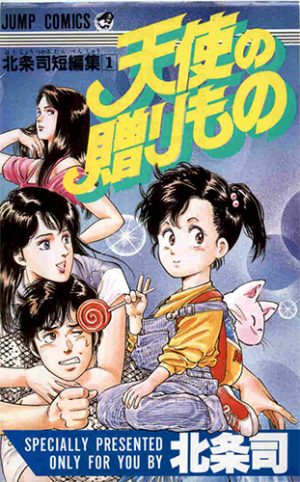
- Genre: Romance, Comedy
- Volumes: 1
- Published: July 1980
So what do you do when your existence is in danger? You travel back to the past and save your parents’ relationship! Masahiro Seguchi is a university senior and a big fan of the Audrey Hepburn film, Roman Holiday. And he couldn’t be any luckier because he has a date with the hottest girl on campus, Ayako. But all of that could change because a mysterious three-year-old girl named Anna calls her father, and refers to his childhood friend Kyoko as her mother. And now everything is complicated!!!
This one shot by Hojo-sensei proves he can do stories beyond his usual comedy and not rely too much on prevented jokes. Long before he did Angel Heart, he proves he can do serious and home to the heart kind of storytelling. Even though the premise seems a little ridiculous, the characters and the relationships are very captivating and progress at a natural pace despite its short length. So if you want something out of the norm in context to Hojo-sensei that doesn’t revolve around action, this may be the title you’re looking for.
2. Cat’s Eye
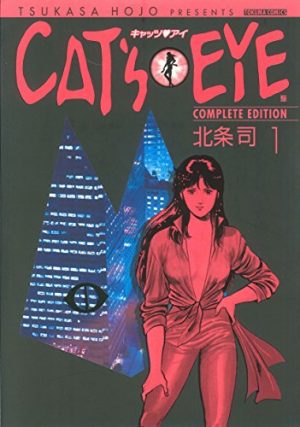
- Genre: Action, Drama, Romance, Comedy, Crime
- Volumes: 18
- Published: Jun 1981 – Jan 1985
Cat’s Eye is about the Kisugi sisters, Hitomi, Rui, and Ai. Café owners by day and leotard wearing cat burglars (no pun intended) by night, they are on the hunt for art pieces that belonged to their father, Michael Heinz, a famous art collector who is presently missing. The Kisugi sisters happen to be pursued by Toshio Utsumi, a lowly police officer who is on the hunt for these mysterious art thieves. And little does he know, Hitomi, his love interest, is one of those thieves. Though on the surface the Kisugi sisters may seem like criminals, in fact, they are not motivated by the thrill of the crime, they are just reclaiming what rightfully belongs to the family.
Its visual appeals are of course the leotards and how sexually attractive the Kisugi sisters look in them. The art style in terms of human designs is much in tune with the style of the 1980s fashion of the time, as well as the hairstyles. Hojo-sensei has a good sense of using sexuality as an appeal to get the reader’s eye and excellent storytelling to keep them hooked. His shadowing and texturing style perfectly reflects the darker lighting he aims for and the agile-centric action sequences are very intricate and exciting. So if you like ladies that have no choice but to take the law into their own hands, Cat’s Eye is for you! Last, check out the anime for its really catchy opening theme song.
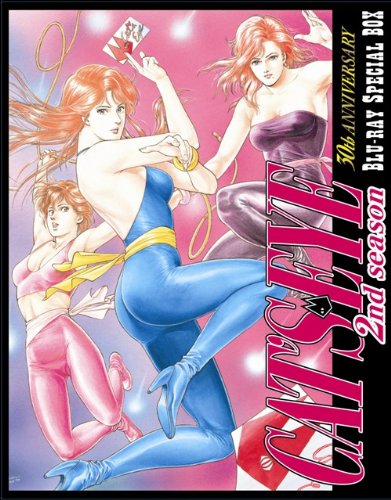
1. City Hunter
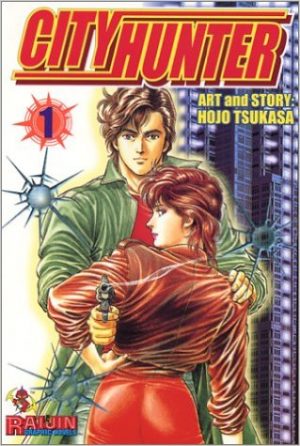
- Genre: Comedy, Mystery, Action, Adventure, Romance
- Volumes: 35
- Published: Feb 1985 – Nov 1991
And our number one recommendation is City Hunter, which has received not only an anime adaptation, but a Jackie Chan live-action movie (which Jackie Chan considers his worst movie ever), and a Korean adaptation (though the plot strongly differs from the manga). City Hunter centers on Ryo Saeba’s youthful days of debauchery, solving mysteries, and kicking ass. Despite being the self-proclaimed King of Mokkori, he is the best private eye you can find in Tokyo. When his best friend Hideyuki Makimura is gunned down in cold blood, he brings in his kid sister, Kaori (fact: when this manga debuted, Nobuhiko Horie, his publisher at the time actually named his daughter Kaori after this character), as his live in assistant and tries to keep Ryo on a leash (or banged by a giant mallet weighing numerous tons).
Even though the series has its dark elements, it is much more comedy driven with Ryo’s attempts at getting laid and Kaori’s reactions to them. They have a pretty unique tension that lasts throughout the series. Ryo may be flawed in terms of his pick up skills, but when it comes to solving a mystery, he can get the job done. But you put a gun in his hand, he can make the impossible possible. What makes the series feel complete is how truly multi-dimensional as a character Ryo can be. One moment his motivations are impure, and he achieves something noble by the time he solves a case.
Though it is a great manga, the anime does give a complete feel with the performance of Akira Kamiya (also most famous as the voice of Kenshiro from Hokuto no Ken) as Ryo. As for the art, the beginning of the series will feel a bit more cartoonish, but Hojo-sensei’s cross hatching, shadowing, and texturing is still refined and the series goes through quite an evolution with its design to the end where it becomes much sharper, which was more of the style of the 90s while it was more circular in the 80s.
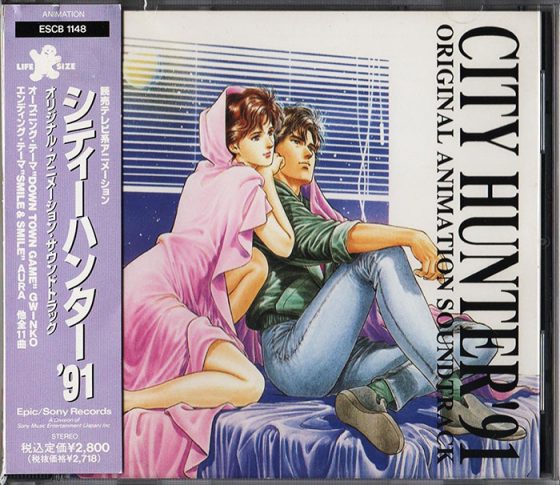
Final Thoughts
Hojo-sensei’s contributions to manga go beyond his original works. During his time on City Hunter, Takehiko Inoue, who you may know as the creator of Slam Dunk, happened to have been his student during that period. The use of texturing through shadowing and cross-hatching is also very prominent in Inoue-sensei’s works. In addition, he happens to be very good friends with Buronson, the co-creator of Hokuto no Ken. When Toei released their movie series, Hojo-sensei contributed to the movies by designing Reina, an original character.
Last, he is a very close friend to Ryo Saeba’s voice actor, Akira Kamiya, and when the Hanshin Earthquake happened in January 1995, they participated in a charity together. The fact they use their fame to help those in need is a most admirable trait. Though most of these titles are old school, they are timeless. But if you want to know about what Japan’s hot economic streak was like back in their golden days, his mangas might do the trick.

